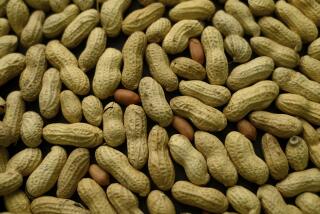Therapy to suppress peanut allergies is reported
- Share via
After years of frustration, allergists meeting in Washington proclaimed a small but significant victory against life-threatening peanut allergies.
Five children, long urged to avoid peanuts like the plague, today tote peanut-butter-and-jelly sandwiches in their lunch boxes, blithely share candy with friends and accept snacks at other people’s homes without quizzing their hosts on the treats’ ingredients.
The children appear to have lost their allergies, said Dr. Wesley Burks, a Duke University pediatric allergist who presented the results of two clinical trials Sunday at a meeting of the American Academy of Allergy, Asthma and Immunology.
The unpublished trials tested whether peanut-allergic patients could be helped to tolerate peanuts by consuming tiny but increasing doses of the food, which induces hives, itching or swelling and is responsible for about half of the 150 annual deaths associated with food allergies in the United States. The studies are the first in a series of promising efforts to push back this dangerous, and growing, allergy.
As many as 3 million Americans have an allergy to peanuts, and usually also to tree nuts such as almonds and walnuts. The percentage of U.S. children with a food allergy jumped 18% in the decade leading to 2007, according to the Centers for Disease Control and Prevention, and there has been a fourfold increase in children’s hospitalizations for food allergies in recent years. Researchers have puzzled over the cause of this rapid rise; some have suggested that childrens’ dwindling exposure to dirt, soil and animals has driven the increase.
Though the studies are small and preliminary, Burks said the group planned to enroll more children in the research, and he hoped that within two to three years, the first of several treatments for peanut allergies will be available to physicians.
“We’re encouraged,” said Robert Pacenza, executive director of the Food Allergy Initiative, a patient group active in promoting research and educating the public about the dangers of food allergies. Though only five children have so far had a seemingly complete reversal of their allergy, that’s five that have never been seen before, he said.
In the studies, conducted by a joint team of researchers from Duke University Medical Center and the Arkansas Children’s Hospital Research Institute, children started on the equivalent of 1/1,000th of a peanut and progressively worked their way up.
In the first study, 33 highly allergic children underwent the so-called oral immunotherapy treatment. Burks reported on nine who had been followed for 2 1/2 years. Five had weathered several food challenges -- eating a substantial helping of peanuts -- without incident, under the eyes of a researcher armed with a syringe full of epinephrine to counter any sudden reaction that might occur.
All five started the trial with slightly lower allergic sensitivity than the average subject. They have been allowed to discontinue daily therapy, though their peanut intake is still monitored, as are immune reactions that might signal a return of their peanut sensitivity.
Burks said that he was unsure how long the effect would last but that the five children were the first ever to exhibit “long-term tolerance” of peanuts after having been diagnosed as allergic.
“They’re eating peanut candy, peanut-butter-and-jelly sandwiches, whatever they want,” Burks said.
The second study, though very small, is of a design that is considered to be the gold standard of research. In it, 18 subjects were divided into two groups, one of which got oral immunotherapy and the second, a placebo. The children were fed small but growing portions of peanut protein and were periodically tested to see whether the dose could be increased without reaction.
In Burks’ report on the 10 children who had been in treatment longest (from six to eight months), five given the placebo treatment could tolerate the equivalent of about one peanut before experiencing allergic symptoms. All five on oral immunotherapy could eat the equivalent of 13 to 15 peanuts without distress.
The studies, which were the buzz of the allergists’ conference this year, are among the first products of a new Food Allergy Research Consortium, established by the National Institutes of Health in 2005 with a $22-million grant.
Some of the consortium’s other early findings received their first public airing at the allergy meeting. A study using mice found that a traditional Chinese herbal medicine showed promise in reducing allergic reactions to peanuts; another trial showed that applying small amounts of peanut extract on the skin appeared to build tolerance in peanut-allergic mice.
Other approaches promise more advanced therapies down the road. One -- expected to begin human trials this year -- is a peanut allergy vaccine, designed to trick the human immune system into giving up its defense against peanuts.
The injectable vaccine, under investigation at Mount Sinai Hospital in New York, would be made of recombinant peanut protein -- essentially a chemical replica of peanut protein but scrubbed of the components that trigger an immune attack. Researchers hope that a child’s immune system would learn to let the real protein pass without mounting an attack if exposed to this harmless protein via a vaccine.
Peanut allergies are among the most severe of food allergy reactions, experts said. And though most children allergic to milk or eggs grow out of those conditions, only about 20% of those with peanut allergies do.
According to reports at the allergy meeting, the stress of managing a child’s peanut allergy weighs most heavily upon mothers, imposes a heavy financial burden on families and limits family vacations.
Among the findings: 68% of families with a food-allergic child limit where they will go on vacation, with most refusing to travel outside the U.S. At their vacation destinations, 51% of those with food allergies say they eat most meals in their rooms. Compared with the general population, those who care for children with food allergies were more likely to stop working, reduce work hours and incur financial problems.
Jenny Kales of La Grange Park, Ill., who publishes the Nut-Free Mom Blog, said she would be the first to welcome a cure for the food allergy that nearly killed her daughter, Alexandra, five years ago. But without a lot more evidence, she’s skeptical. “This flies in the face of science up to now,” Kales said.
Kales questioned whether her 9-year-old daughter would be willing to undergo a treatment that would expose her to a food that repulses and scares her. (Alexandra has told her she “would consider it.”)
Many questions remain, said Dr. Scott H. Sicherer of Mount Sinai School of Medicine’s Jaffe Food Allergy Institute and a medical advisor to the Food Allergy Initiative.
“How does it translate into what people can practically do in their lives?” Sicherer said. “How much are they protected? Does it really make the allergy go away or is it just a temporary thing that’ll come back when therapy stops?”
The concept of “immunotherapy” for a food allergy has a long history and a string of partial successes, Sicherer said. The approach has worked to cure an allergy to penicillin. But as soon as the exposure therapy is discontinued, the allergy roars back.
More recently, researchers at Mount Sinai, Duke and Johns Hopkins University successfully used oral immunotherapy to build the tolerance of children severely allergic to milk. But though 13 of 15 subjects increased their tolerance for milk and 1 in 4 was able to drink all the milk they wanted, researchers reported that allergic reactions, some of them serious, were common.
--






